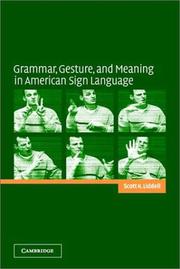| Listing 1 - 3 of 3 |
Sort by
|
Book

ISBN: 1501511807 1501515705 Year: 2017 Publisher: Berlin, Germany De Gruyter
Abstract | Keywords | Export | Availability | Bookmark
 Loading...
Loading...Choose an application
- Reference Manager
- EndNote
- RefWorks (Direct export to RefWorks)
We gratefully acknowledge the financial support of COST (European Cooperation in Science and Technology), funded by the Horizon 2020 Framework Programme of the European Union. Current grammatical knowledge about particular sign languages is fragmentary and of varying reliability, and it appears scattered in scientific publications where the description is often intertwined with the analysis. In general, comprehensive grammars are a rarity. The SignGram Blueprint is an innovative tool for the grammar writer: a full-fledged guide to describing all components of the grammars of sign languages in a thorough and systematic way, and with the highest scientific standards.The work builds on the existing knowledge in Descriptive Linguistics, but also on the insights from Theoretical Linguistics. It consists of two main parts running in parallel: the Checklist with all the grammatical features and phenomena the grammar writer can address, and the accompanying Manual with the relevant background information (definitions, methodological caveats, representative examples, tests, pointers to elicitation materials and bibliographical references). The areas covered are Phonology, Morphology, Lexicon, Syntax and Meaning. The Manual is endowed with hyperlinks that connect information across the work and with a pop-up glossary.The SignGram Blueprint will be a landmark for the description of sign language grammars in terms of quality and quantity.

ISBN: 0521816203 0521016509 1107134358 0511178638 0511065167 0511058837 0511305850 0511615051 1280420014 1139148338 0511073623 9780511065163 9780521816205 9780521016506 9780511058837 9780511073625 9781139148337 9780511615054 9781280420016 9786610420018 6610420017 Year: 2003 Publisher: Cambridge New York Cambridge University Press
Abstract | Keywords | Export | Availability | Bookmark
 Loading...
Loading...Choose an application
- Reference Manager
- EndNote
- RefWorks (Direct export to RefWorks)
In sign languages of the deaf some signs can meaningfully point toward things or can be meaningfully placed in the space ahead of the signer. This obligatory part of fluent grammatical signing has no parallel in vocally produced languages. This book focuses on American Sign Language to examine the grammatical and conceptual purposes served by these directional signs. It guides the reader through ASL grammar, the different categories of directional signs, the types of spatial representations signs are directed toward, how such spatial conceptions can be represented in mental space theory, and the conceptual purposes served by these signs. The book demonstrates a remarkable integration of grammar and gesture in the service of constructing meaning. These results also suggest that our concept of 'language' has been much too narrow and that a more comprehensive look at vocally produced languages will reveal the same integration of gestural, gradient, and symbolic elements.
American Sign Language --- Gesture --- Space and time in language --- Grammar --- Semantics --- Gesture. --- Space and time in language. --- Grammar. --- Semantics. --- Arts and Humanities --- Language & Linguistics --- AMESLAN (Sign language) --- ASL (Sign language) --- Sign language --- Language and languages --- Mudra --- Acting --- Body language --- Elocution --- Movement (Acting) --- Oratory --- American Sign Language - Grammar --- American Sign Language - Semantics --- #KVHA:Gebarentaal; Verenigde Staten --- #KVHA:Grammatica; Gebarentaal
Book
ISBN: 1283428261 9786613428264 1614510695 1614510687 1614510679 9781614510673 Year: 2011 Publisher: Berlin ; Boston : De Gruyter Mouton,
Abstract | Keywords | Export | Availability | Bookmark
 Loading...
Loading...Choose an application
- Reference Manager
- EndNote
- RefWorks (Direct export to RefWorks)
Sign languages and spoken languages have an equal capacity to communicate our thoughts. Beyond this, however, while there are many similarities, there are also fascinating differences, caused primarily by the reaction of the human mind to different modalities, but also by some important social differences. The articulators are more visible and use larger muscles with consequent greater effort. It is difficult to visually attend to both a sign and an object at the same time. Iconicity is more systematic and more available in signs. The body, especially the face, plays a much larger role in sign. Sign languages are more frequently born anew as small groups of deaf people come together in villages or schools. Sign languages often borrow from the written form of the surrounding spoken language, producing fingerspelling alphabets, character signs, and related signs. This book examines the effects of these and other differences using observation, experimentation and theory. The languages examined include Asian, Middle Eastern, European and American sign languages, and language situations include home signers and small village signers, children, gesturers, adult signers, and non-native signers.
Grammar, Comparative and general - Phonology, Comparative. --- Sign language -- Grammar, Comparative. --- Sign language -- History. --- Sign language - Phonology, Comparative. --- Sign language -- Variation. --- Sign language. --- Sign language --- Grammar, Comparative and general --- Languages & Literatures --- Philology & Linguistics --- Phonology, Comparative --- Phonology, Comparative. --- Comparative phonology --- Contrastive phonetics --- Contrastive phonology --- Phonetics, Contrastive --- Phonology, Contrastive --- Deaf --- Gesture language --- Contrastive linguistics --- Language and languages --- Gesture --- Signs and symbols --- Phonetics. --- Phonology. --- Sign Language. --- Linguistics --- Philology --- Sign language - Phonology, Comparative --- Grammar, Comparative and general - Phonology, Comparative
| Listing 1 - 3 of 3 |
Sort by
|

 Search
Search Feedback
Feedback About UniCat
About UniCat  Help
Help News
News